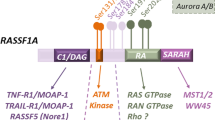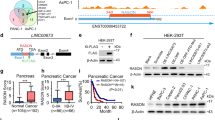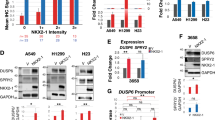Abstract
The Ras-assocation domain family (RASSF) of tumor suppressor proteins until recently contained six proteins named RASSF1–6. Recently, four novel family members, RASSF7–10, have been identified by homology searches for RA-domain-containing proteins. These additional RASSF members are divergent and structurally distinct from RASSF1–6, containing an N-terminal RA domain and lacking the Sav/RASSF/Hpo (SARAH) domain. Here, we show that RASSF8 is ubiquitously expressed throughout the murine embryo and in normal human adult tissues. Functionally, RNAi-mediated knockdown of RASSF8 in non-small-cell lung cancer (NSCLC) cell lines, increased anchorage-independent growth in soft agar and enhanced tumor growth in severe combined immunodeficiency (SCID) mice. Furthermore, EdU staining of RASSF8-depleted cells showed growth suppression in a manner dependent on contact inhibition. We show that endogenous RASSF8 is not only found in the nucleus, but is also membrane associated at sites of cell–cell adhesion, co-localizing with the adherens junction (AJ) component β-catenin and binding to E-cadherin. Following RASSF8 depletion in two different lung cancer cell lines using alternative small interfering RNA (siRNA) sequences, we show that AJs are destabilized and E-cadherin is lost from the cell membrane. The AJ components β-catenin and p65 are also lost from sites of cell–cell contact and are relocalized to the nucleus with a concomitant increase in β-catenin-dependent and nuclear factor-κB (NF-κB)-dependent signaling following RASSF8 depletion. RASSF8 may also be required to maintain actin -cytoskeletal organization since immunofluorescence analysis shows a striking disorganization of the actin- cytoskeleton following RASSF8 depletion. Accordingly, scratch wound healing studies show increased cellular migration in RASSF8-deficient cells. These results implicate RASSF8 as a tumor suppressor gene that is essential for maintaining AJs function in epithelial cells and have a role in epithelial cell migration.
This is a preview of subscription content, access via your institution
Access options
Subscribe to this journal
Receive 50 print issues and online access
$259.00 per year
only $5.18 per issue
Buy this article
- Purchase on Springer Link
- Instant access to full article PDF
Prices may be subject to local taxes which are calculated during checkout





Similar content being viewed by others
References
Brembeck FH, Rosário M, Birchmeier W . (2006). Balancing cell adhesion and Wnt signaling, the key role of beta-catenin. Curr Opin Genet Dev 16: 51–59.
Charalambous M, Smith FM, Bennett WR, Crew TE, Mackenzie F, Ward A . (2003). Disruption of the imprinted Grb10 gene leads to disproportionate overgrowth by an Igf2-independent mechanism. Proc Natl Acad Sci USA 100: 8292–8297.
Chen L, Johnson RC, Milgram SL . (1998). P-CIP1, a novel protein that interacts with the cytosolic domain of peptidylglycine alpha-amidating monooxygenase, is associated with endosomes. J Biol Chem 273: 33524–33532.
Dallol A, Agathanggelou A, Fenton SL, Ahmed-Choudhury J, Hesson L, Vos MD et al. (2004). RASSF1A interacts with microtubule-associated proteins and modulates microtubule dynamics. Cancer Res 64: 4112–4116.
Dallol A, Agathanggelou A, Tommasi S, Pfeifer GP, Maher ER, Latif F . (2005). Involvement of the RASSF1A tumor suppressor gene in controlling cell migration. Cancer Res 65: 7653–7659.
Dallol A, Hesson LB, Matallanas D, Cooper WN, O'Neill E, Maher ER et al. (2009). RAN GTPase is a RASSF1A effector involved in controlling microtubule organization. Curr Biol 19: 1227–1232.
Debeer P, Schoenmakers EF, Twal WO, Argraves WS, De Smet L, Fryns JP et al. (2002). The fibulin-1 gene (FBLN1) is disrupted in a t(12;22) associated with a complex type of synpolydactyly. J Med Genet 39: 98–104.
Dejana E, Rudini N . (2008). Adherens junctions. Curr Biol 18: R1080-2.
Deng J, Miller SA, Wang HY, Xia W, Wen Y, Zhou BP et al. (2002). beta-catenin interacts with and inhibits NF-kappa B in human colon and breast cancer. Cancer Cell 2: 323–334.
Deng J, Xia W, Miller SA, Wen Y, Wang HY, Hung MC . (2004). Crossregulation of NF-kappaB by the APC/GSK-3bet/beta-catenin pathway. Mol Carcinog 39: 139–146.
Downward J . (2009). Cancer: A tumour gene’s fatal flaws. Nature 462: 44–45.
Falvella FS, Manenti G, Spinola M, Pignatiello C, Conti B, Pastorino U et al. (2006). Identification of RASSF8 as a candidate lung tumor suppressor gene. Oncogene 25: 3934–3938.
Hayden MS, Ghosh S . (2008). Shared principles in NF-kappaB signaling. Cell 132: 344–362.
Hesson LB, Cooper WN, Latif F . (2007a). The role of RASSF1A methylation in cancer. Dis Markers 23: 73–87.
Hesson LB, Cooper WN, Latif F . (2007b). Evaluation of the 3p21.3 tumour-suppressor gene cluster. Oncogene 26: 7283–7301.
Hesson LB, Dunwell TL, Cooper WN, Catchpoole D, Brini AT, Chiaramonte R et al. (2009). The novel RASSF6 and RASSF10 candidate tumour suppressor genes are frequently epigenetically inactivated in childhood leukaemias. Mol Cancer 8: 42.
Katagiri K, Maeda A, Shimonaka M, Kinashi T . (2003). RAPL, a Rap1-binding molecule that mediates Rap1-induced adhesion through spatial regulation of LFA-1. Nat Immunol 4: 741–748.
Langton PF, Colombani J, Chan EH, Wepf A, Gstaiger M, Tapon N . (2009). The dASPP-dRASSF8 complex regulates cell-cell adhesion during drosophila retinal morphogenesis. Curr Biol 19: 1969–1978.
MacDonald BT, Tamai K, He X . (2009). Wnt/beta-catenin signaling: components, mechanisms, and diseases. Dev Cell 17: 9–26.
Richter AM, Pfeifer GP, Dammann RH . (2009). The RASSF proteins in cancer; from epigenetic silencing to functional characterization. Biochim Biophys Acta 1796: 114–128.
Rodriguez-Viciana P, Sabatier C, McCormick F . (2004). Signaling specificity by Ras family GTPases is determined by the full spectrum of effectors they regulate. Mol Cell Biol 24: 4943–4954.
Scheel H, Hofmann K . (2003). A novel interaction motif, SARAH, connects three classes of tumor suppressor. Curr Biol 13: R899R900.
Sherwood V, Manbodh R, Sheppard C, Chalmers AD . (2008). RASSF7 is a member of a new family of RAS association domain-containing proteins and is required for completing mitosis. Mol Biol Cell 19: 1772–1782.
Solanas G, Porta-de-la-Riva M, Agustí C, Casagolda D, Sánchez-Aguilera F, Larriba MJ et al. (2008). E-cadherin controls beta-catenin and NF-kappaB transcriptional activity in mesenchymal gene expression. J Cell Sci 121 (Pt 13): 2224–2234.
Vos MD, Martinez A, Elam C, Dallol A, Taylor BJ, Latif F et al. (2004). A role for the RASSF1A tumor suppressor in the regulation of tubulin polymerization and genomic stability. Cancer Res 64: 4244–4250.
Wang F, Grigorieva EV, Li J, Senchenko VN, Pavlova TV, Anedchenko EA et al. (2008). HYAL1 and HYAL2 inhibit tumour growth in vivo but not in vitro. PLoS One 3: e3031.
Acknowledgements
Work in FL's laboratory is supported by Cancer Research UK, Breast Cancer Campaign and Sport Aiding Medical Research for Kids (SPARKS). Work in ADC's laboratory is funded by MRC and Cancer Research UK, and AR by a Marie Curie PhD studentship. EZ was supported by research grants from the Swedish Cancer Society, the Swedish Research Council and the Swedish Foundation for International Cooperation in Research and Higher Education (STINT), the Swedish Instituteand Karolinska Institute.
Author information
Authors and Affiliations
Corresponding author
Ethics declarations
Competing interests
The authors declare no conflict of interest.
Additional information
Supplementary Information accompanies the paper on the Oncogene website
Supplementary information
Rights and permissions
About this article
Cite this article
Lock, F., Underhill-Day, N., Dunwell, T. et al. The RASSF8 candidate tumor suppressor inhibits cell growth and regulates the Wnt and NF-κB signaling pathways. Oncogene 29, 4307–4316 (2010). https://doi.org/10.1038/onc.2010.192
Received:
Revised:
Accepted:
Published:
Issue Date:
DOI: https://doi.org/10.1038/onc.2010.192
Keywords
This article is cited by
-
Consensus clustering methodology to improve molecular stratification of non-small cell lung cancer
Scientific Reports (2023)
-
Evidence for the circulating microRNA hsa-let-7d-3p as a potential new biomarker for sepsis in human subjects
European Journal of Medical Research (2022)
-
Afadin couples RAS GTPases to the polarity rheostat Scribble
Nature Communications (2022)
-
RASSF9 promotes NSCLC cell proliferation by activating the MEK/ERK axis
Cell Death Discovery (2021)
-
MicroRNA-1269 promotes cell proliferation via the AKT signaling pathway by targeting RASSF9 in human gastric cancer
Cancer Cell International (2019)



